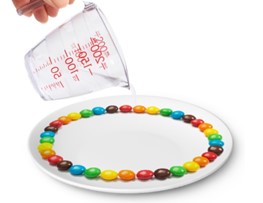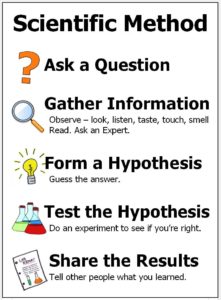This experiment is so easy to do and enjoyable to even the youngest scientists! We often do it at our CEFA Early Learning schools with our one year old students. All you need is a bag of skittles, a plate and a scientist in the making!
Best Ages for This Activity
One to five
How to Make It
Ingredients
- A bag of skittles
- A white plate
- ½ cup pf hot water
Let’s Get Started
- Invite your child to try a science experiment using skittles
- Explain that as a first step, you will place the skittles around the rim of the place. It is important that you encourage your child to do this so that they practice their fine motor skills. You can also encourage them to place them in a pattern (a yellow one, a green one, an orange one, a purple one, etc.), which will work on their math You don’t have to use all the colours, just the ones your child wants to try. What colours go where, or even how many colours you use does not matter. Just keep in mind that it would work better if you alternated colours, just like on the picture shown.
- Encourage your child to form a circle around the plate:

- Once the skittles are around the plate, ask your child: what do you think will happen if we add hot water to the centre of our plate? Encourage your child to write down or draw their predictions (hypotheses)
- Test: invite your child to pour hot water in the centre of the plate. You will need just enough water so that the skittles are all touching water, but not submerged. You can also start a timer to see how long the reaction takes (math) and take photos. The most important aspect is to observe and describe what is happening.
- Your child will notice that as the candy shells dissolve in hot water, they create a beautiful rainbow effect! Observe what shape it takes.
- Invite them to draw what happened (writing).
- Don’t forget to use the steps of the scientific method:

- Questions you can ask:
- What do you think happened to form the colours in the water?
- How long did it take for the colours to form a rainbow?
- What do you think would happen if we tried with less skittles? Or two rows of skittles? Or two colours only? Or three?
- Do you think the candy will taste different after it makes a rainbow?
- In what way?
- Do you know why the colours don’t mix as they dissolve? Each colour of candy coating has a different sugar density, which is why they stay separated.
Learning Opportunities
This is a fun S.T.E.M. activity where your child can see a chemical reaction as it happens. It has so many opportunities to learn math especially: You can learn colours, you can count, you can make pairs, or patterns, you can measure how long it takes for the rainbow to form (measuring time) and even compare two plates side by side using cold water, warm water and hot water. All the while, use the scientific method to predict what will happen, test and record your results.
Make sure you use as much math vocabulary as you can (for example, measure time, measure the intensity of the colour as it dissolves, etc. Use descriptive words like long/longer/longest, fast, intense, etc.) and use as many opportunities as you can to measure, sequence, count and compare.
CEFA tip: Remember to let your child do as much of the process as they are capable of (you will have to help with the hot water, though).
Books Your Child Might Like
Toys Your Child Might Like
For 3+
As an Amazon Associate I earn from qualifying purchases